By Amit Kumar, TwoCircles.net
Khagrabari: On April 8, Narendra Modi was in Barpeta for campaigning, but for a village in Baksa district, about 30 kms from where Modi addressed thousands of BJP supporters, the mood could not have been more different.
Given that nearly all forms of public transport in Barpeta had been requisitioned for the Modi rally, reaching the village of Khagrabari, located in Baksa district of BTAD, was a task in itself.
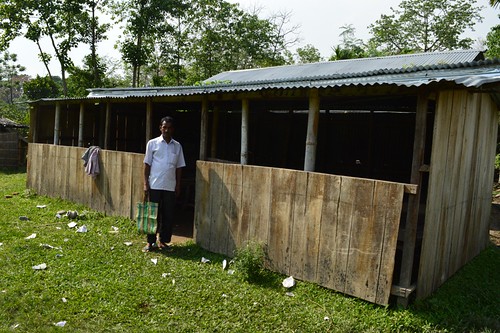
The driver of a rickety, old auto rickshaw promised to drop me near the Goverdhana Police station, and asked me to pray that I get a connecting vehicle from there to take me a further 10kms to Naryangudi, a village which is about a km before the Manas National park. From Narayangudi, a boat would take me to Khagrabari, which, in May 2014, had seen nearly 40 Muslims killed by NDFB (Sonbijit) militants.
The road to Goverdhana from Barpeta was 20 kms of state highway torture; the vehicle jumping all along the way and barely crossing speeds of 20 km/hr. At 11 am, almost one and a half hours after having boarded the auto, I had been dropped at the Goverdhana Police station. Of course, there were no vehicles to help me go further, so I had no option but to walk the remaining 8-9 kms. Nearly two hours later and having asked almost everyone I saw on the road for directions (keep going straight! That was all I was told) I had reached Narayangudi. Now, I had to wait for a boat.
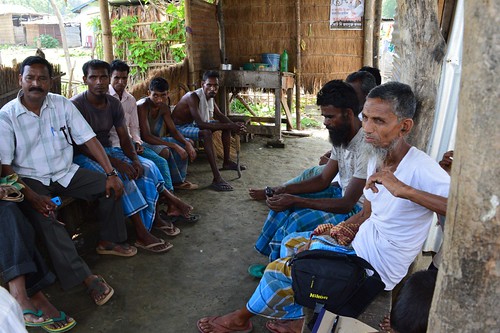
After waiting under the blazing sun for about 20 minutes, one boat arrived and agreed to take me to the village for a small amount. Khagrabari is just about visible from Narayangudi, but Lukman Ali, the boatman, said that until a few years ago this was not the case. “When the water in the river was less (as was the case now), you could actually walk across the river and go to the village. But due to land erosion, that village has lost a lot of land and is much further away,” he says. While “walking” may not have been a realistic assessment, it was easy to understand what he said.
Although the water in the River Beki was shallow, the current was strong nevertheless, and the old boat bellowed thick, black smoke in its attempt to navigate through pristine waters. Forty five minutes later, with the engine sounding like it breathed its last puff of black smoke, we had arrived in Khagrabari. But it barely looked like a village, and to understand the reason behind that, we have to rewind to May 2, 2014.
The May Massacre
Two weeks before the NDA came to power, Amjad Ali, a primary school teacher in the village of Khagrabari, received a phone call. He had finished teaching and come back to Narayangudi, where he lived. The phone signal was weak, but the little that he heard shook him to the core. “It was a minute-long call and I could barely hear anything except crying and the word ‘fire’. I knew the call was from the other side of the river. There had been an attack, and I along with other people, immediately took a boat and rushed to the spot,” he says.
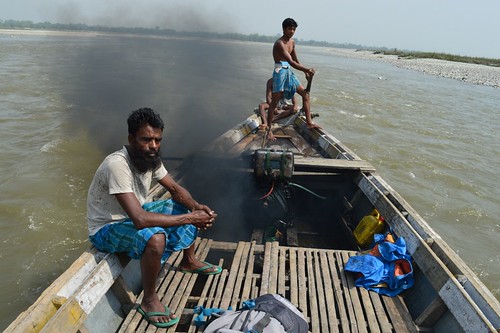
The attacks, over two hours, left close to 40 people dead and, according to locals, two went missing and were never found again. Of the dead, 22 were children under the age of 10. Some had been shot; the younger ones had been torn apart, smashed and shot in their mother’s arms. Some were killed when they jumped in the water. Mothers died and their children were taken to certain death by the waters. Of the 72 houses, 70 were completely gutted. The locals, while narrating the stories, most locals had an expression which suggested that these stories had been talked about a number of times, to a point where everyone assembled remembered all the details, in the same order.
According to Abdul Ghaffur, who saw his brother, his brother’s wife and their child die that day, the attack was not only pre-planned, but also facilitated by the Bodo forest officials. He explains. “Apart from the river, the only other way you can enter the village is through the Manas National Park. From the village, the first Forest Department check post is about three kilometres. How did the forest officials not see them coming? How come no one alerted us or even attempted to stop them?” Another resident says he could recognise forest officials as part of the NDFB gang that attacked them. “Some of the men who were carrying guns were men from the forest officials,” he said. Amjad Ali added, “Even the ballistic reports confirmed that the cartridges were the same as the ones used by the forest rangers. What more proof does one need?” he asked.
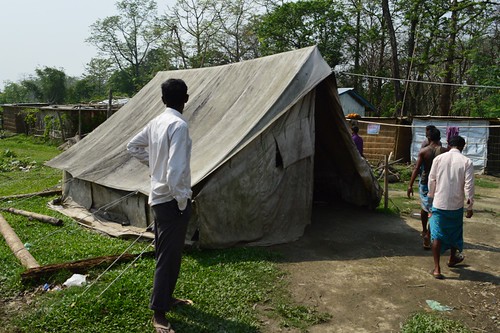
Two years on, victims still live in fear
It would not be wrong to mistake Khagrabari as a refugee camp; for even after two years, almost 50 families still live in makeshift tents. Interestingly, there are close to 15 tin houses and they were provided for by Badruddin Ajmal, the AIUDF supremo, when he had visited the place after the massacre. At that time, he had promised that each family would be given Rs 50,000 as financial assistance and Rs 50,000 to build homes. “We still do not why, or how, only 15 families received the compensation,” says Usman Ali, who lost his wife and child in the massacres. “After that, no one from the party ever visited us to check upon us,” he says. A year ago, Twocircles had done this story about they were waiting for justice. A year later, while they have been paid compensation by the Assam government and the Central government, the fear is still very much present, and understandable. At that time, the families had still been living on the Narayangudi side, but even after coming back not much has changed.
When it comes to elections, this village leaves you scratching your head. Sample this: the village is in Baksa district, which is a part of BTAD. Yet, its constituency is Sorbhog, in Barpeta district. No wonder then, no political leader ever visited the village and in fact, their MLA, Ranjeet Kumar Das of BJP, has never visited them till date, including after the massacre. “The only campaigning that we have seen, or heard, has been on the other side (Narayangudi),” says a resident. “It has nothing to do with us,” he says.
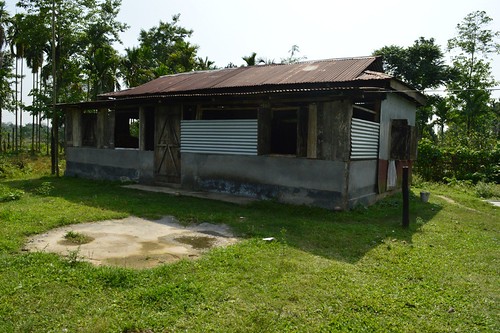
Beyond the massacre, the other reason behind the dire conditions of the villagers is a problem all too familiar to residents around the River Beki: land erosion. As Lukman Ali, the boatman, had pointed out, Khagrabari has also lost close to 35-40 bighas of land to erosion, so for most of the people here who had traditionally been farmers, the option no longer exists. Despite the land erosion however, the village has shrunk in size as families now prefer living close to each other in order to feel safe. “With agriculture gone as an occupation and the looming threat of attacks, we are much safer if we live closer,” adds Ghaffur.
The other reason why the village has shrunk is because now, there is a permanent post of the Assam State Armed Police positioned towards the side facing the Manas National Park. The Post, which was stationed a year ago, has given some relief to the locals, but again, the idea that they have to live under police protection in their own village makes them uneasy. “We are Bengali-speaking Muslims, but we are still residents of Assam. Why is it so difficult to accept this and for how long will our loyalty be questioned?” asks Ghaffur.
Because of the circumstances that the villagers have been facing, issues like water, electricity, medical facility, roads, or even a school beyond the primary level do not even find a mention unless asked about. “We do not have any of these, but when our lives are at stake, people seem to give such issues a pass,” says Ali. For the past ten years, he has been teaching in a makeshift school and says it is unlikely that much will change. For the residents of Khagrabari, the coming elections will give them a chance to voice their opinions. They however doubt if anyone is listening.

